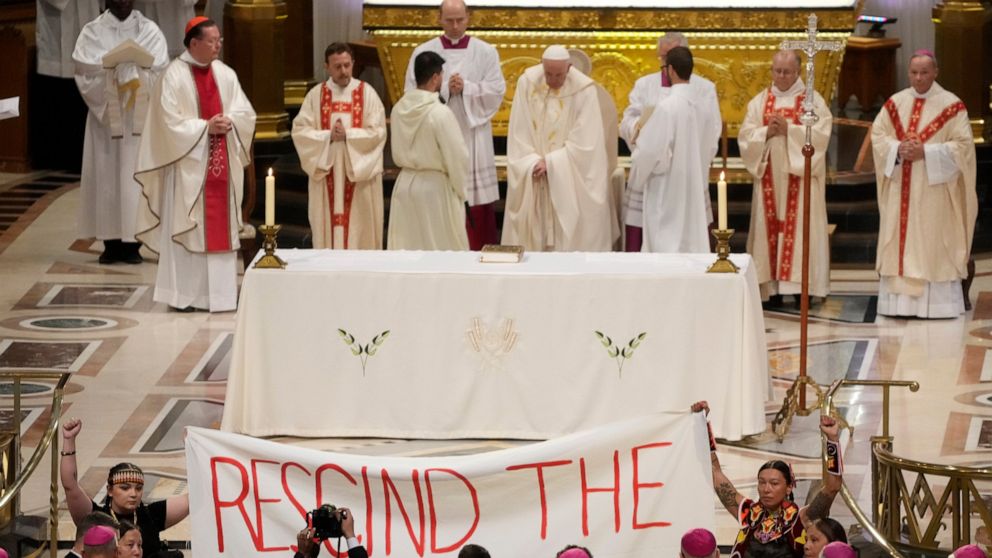ST-ANNE-DE-BEAUPRÉ, Quebec — Pope Francis celebrated Mass Thursday at Canada’s National Shrine and found himself faced with a longstanding demand from Indigenous peoples: to formally rescind the papal decrees that underpin the so-called ‘Doctrine of Discovery’ that has apparently legitimized the colonial era confiscation of indigenous lands and resources.
Just before the start of the mass, two aboriginal women unfurled a banner at the altar of the National Shrine of Sainte-Anne-de-Beaupré which read: “Repeal the doctrine” in bright red and black letters. The demonstrators were escorted out and the mass passed without incident, although the women then carried the banner out of the basilica and draped it over the balustrade.
The brief protest underscored one of the lingering issues facing the Holy See following Francis’ historic apology for the Catholic Church’s involvement in Canada’s notorious residential schools, where generations of Indigenous people were forcibly removed from their families and cultures to assimilate them into Canadian Christian society. . Francis spent the week in Canada seeking to atone for the trauma and suffering of First Nations, Métis and Inuit.
Beyond the apologies, the indigenous people called on Francis to formally rescind 15th-century papal decrees, or bulls, that provided European kingdoms with religious support to expand their territories in an effort to spread Christianity. These executive orders were seen as supporting the Doctrine of Discovery, a legal doctrine coined in an 1823 United States Supreme Court decision that came to be understood to mean that ownership and sovereignty over the land passed to the Europeans because they “discovered” it.
Prime Minister Justin Trudeau raised the need for the Holy See to ‘deal with the Doctrine of Discovery,’ as well as other issues, including the return of Indigenous artifacts to the Vatican Museums, during his private talks with Francis Wednesday, Trudeau’s office said.
Murray Sinclair, the First Nations chair of the Truth and Reconciliation Commission of Canada, cited the doctrine in a statement this week, welcoming Francis’ apology but calling on him to fully embrace the church’s role in the system of Canadian boarding schools.
“Driven by the Doctrine of Discovery and other Church beliefs and doctrines, Catholic leaders not only enabled the Government of Canada, but pushed it even further in its work to commit cultural genocide of the peoples natives,” Sinclair said. “It was more than the work of a few bad actors – it was a concerted institutional effort to remove children from their families and cultures, all in the name of Christian supremacy.”
Church officials have insisted that these papal decrees have long since been rescinded or replaced with others that fully recognize the rights of indigenous peoples to live on their lands, and say the original bulls are meaningless. legal or moral today.
And Francis during the trip repeatedly reaffirmed these rights and rejected the policies of assimilation that drove the residential school system, without however referring to the previous decrees of his predecessors legitimizing colonialism.
Trip organizers from the Vatican and Canada have confirmed that a new statement is in the works to address Indigenous peoples’ demands for a current formal repudiation, although it is not expected to be issued during Francis’ visit.
“The Vatican has clarified that papal bulls associated with the Doctrine of Discovery have no legal or moral authority in the Church,” Neil MacCarthy, communications manager for the papal visit, told The Associated Press in a statement. E-mail. “However, we understand the drive to name these texts, acknowledge their impact, and relinquish the concepts associated with them.”
Asked about the protest on Thursday, MacCarthy said: “We recognize that there are very passionate feelings on a number of issues, including the Doctrine of Discovery. The brief peaceful protest did not disrupt the service and the group. had the opportunity to voice their concerns.”
The service itself incorporated many Indigenous elements and people, including a moving moment when a woman in Indigenous dress wept in front of Francis as she brought him the offering gifts. Francis did not mention the question of doctrine in his homily, which spoke in general terms of reconciliation and the need for hope.
The Vatican clearly anticipated that the problem would arise during the trip. In an essay in the current issue of the Vatican-endorsed Jesuit journal La Civilta Cattolica, Reverend Federico Lombardi acknowledged that the issue remains important for indigenous peoples, but stressed that the Holy See’s position on the repudiation of principles underlying the fifteenth century bulls is clear.
Lombardi, the retired Vatican spokesman, cited the subsequent bull of 1538 “Sublimis Deus” which asserted that indigenous peoples “shall not in any case be deprived of their liberty or the possession of their property, even if ‘they are out of the faith of Jesus Christ; and that they can and should freely and legitimately enjoy their liberty and the possession of their property; in no case should they be reduced to slavery.
For its part, the Canadian Bishops’ Conference issued a statement in 2016 strongly repudiating the doctrine as well as the related concept of “terra nullius”. This 19th-century term is also understood to legitimize the seizure of Indigenous lands, as European settlers considered land to be “unused” if it showed no signs of European agricultural practices.
“We reject the claim that the first taker or discoverer principle, often described today by the terms Doctrine of Discovery and terra nullius, could be applied to lands already inhabited by Indigenous peoples,” the statement said. bishops. “We reject the claim that the mere absence of European agricultural practices, technologies or other aspects common to European culture, could justify claiming land as if it had no owner.”
———
Winfield reported from Quebec.
———
Associated Press religious coverage receives support through the AP’s collaboration with The Conversation US, with funding from Lilly Endowment Inc. The AP is solely responsible for this content.

